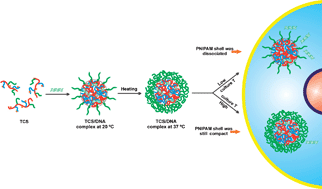Thermo-responsive transfection of DNA complexes with well-defined chitosan terpolymers
Abstract
Serial thermo-sensitive CS(-g-PDMAEMA)-g-PNIPAM terpolymers (termed as

* Corresponding authors
a
School of Mechanical and Aerospace Engineering, Nanyang Technological University, 50 Nanyang Avenue, Singapore
E-mail:
mlli@ntu.edu.sg
Fax: +65-6791 1859
Tel: +65-6790 6285
b Division of Bioengineering, Faculty of Engineering, National University of Singapore, 7 Engineering Drive 1, Singapore
c School of Physical and Mathematical Sciences, Nanyang Technological University, 21 Nanyang Link, Singapore
Serial thermo-sensitive CS(-g-PDMAEMA)-g-PNIPAM terpolymers (termed as

 Please wait while we load your content...
Something went wrong. Try again?
Please wait while we load your content...
Something went wrong. Try again?
H. Bao, Y. Ping, Y. Pan, L. Li, J. Li and L. H. Gan, Soft Matter, 2012, 8, 2518 DOI: 10.1039/C2SM07083A
To request permission to reproduce material from this article, please go to the Copyright Clearance Center request page.
If you are an author contributing to an RSC publication, you do not need to request permission provided correct acknowledgement is given.
If you are the author of this article, you do not need to request permission to reproduce figures and diagrams provided correct acknowledgement is given. If you want to reproduce the whole article in a third-party publication (excluding your thesis/dissertation for which permission is not required) please go to the Copyright Clearance Center request page.
Read more about how to correctly acknowledge RSC content.
 Fetching data from CrossRef.
Fetching data from CrossRef.
This may take some time to load.
Loading related content
